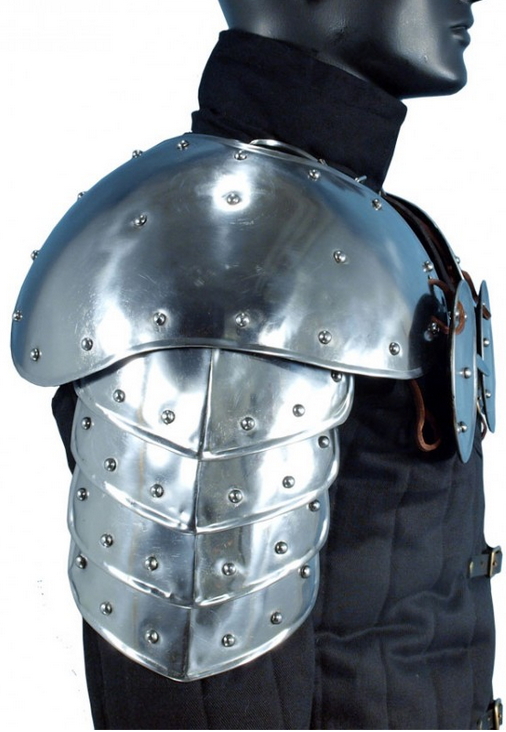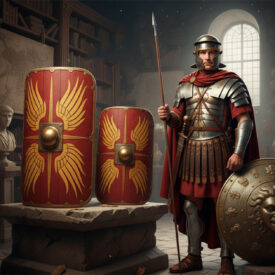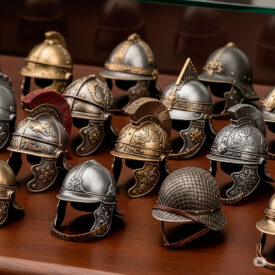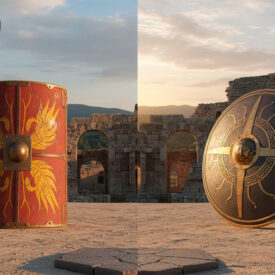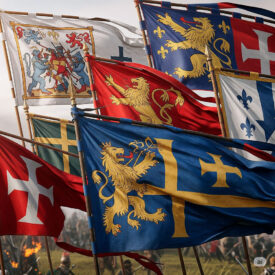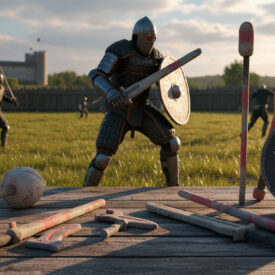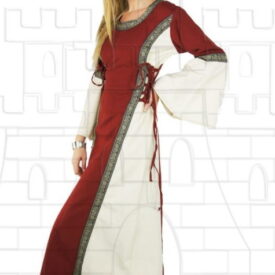The figure of the medieval warrior evokes the image of a formidable combatant, attired in full armor that protected him from head to toe. However, each piece of this imposing cuirass had a specific function and a history of evolution behind it. The medieval warrior pauldrons are a clear example of this, pieces of armor that were perfected over the centuries to offer maximum protection without sacrificing mobility on the battlefield.
In this article, we will delve into the importance of pauldrons, their different types, their evolution through the Middle Ages, and their role in combat and tournaments. You will discover how these pieces, which often go unnoticed compared to the helmet or breastplate, were crucial for the warrior’s survival.
The Need to Protect Shoulders in Medieval Combat
The medieval battlefield was a brutal place. Warriors wielded blunt weapons such as swords, maces, hammers, and axes, designed to inflict maximum damage. The shoulder, with its complex articulation and constant exposure in combat, was a priority target. A well-aimed blow could not only disable an arm but could also be fatal if it reached vulnerable points near the neck or torso.
Initially, protection was limited to chainmail, which, while offering decent defense against cuts, was vulnerable to blunt force trauma. With the rise of impact weapons, the need for more robust defense became evident. This is where metal plate pauldrons, which were anchored to the chainmail or directly to other parts of the armor, began to gain ground.
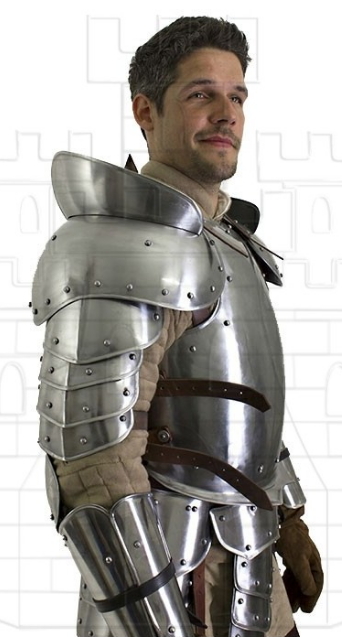
Evolution of Pauldrons: From the 13th to the 16th Century
The evolution of the medieval warrior pauldrons is a fascinating reflection of the advancement of military technology and combat tactics. There was no single type of pauldron; its design adapted to the specific needs of the era and the type of combat.
The First Articulated Pauldrons (13th-14th centuries)
In their early stages, pauldrons were relatively simple pieces, often composed of two or three articulated segments. The idea was to protect the shoulder joint without restricting movement. These pieces, often called shoulder escutcheons, were attached to the breastplate or gambeson and were designed to be as light and maneuverable as possible. However, their design, although ingenious, often made them vulnerable to blows that could disarticulate them.
The Consolidation of Plate Armor (15th century)
The 15th century marked a turning point. With the consolidation of full plate armor, pauldrons evolved into larger and more robust forms. They integrated better with the rest of the harness, offering more complete and stable protection. The new plate pauldrons were wider and attached to the breastplate more securely, allowing the warrior a more fluid and less impeded forward arm movement.
A distinctive feature of these pauldrons was the raised flange at the top, which acted as a protective “collar.” This design was intended to deflect spear blows, preventing them from sliding towards the warrior’s neck or face. This innovation demonstrates the sophistication of the medieval armorer, who designed each piece with the specific dangers of the battlefield in mind.
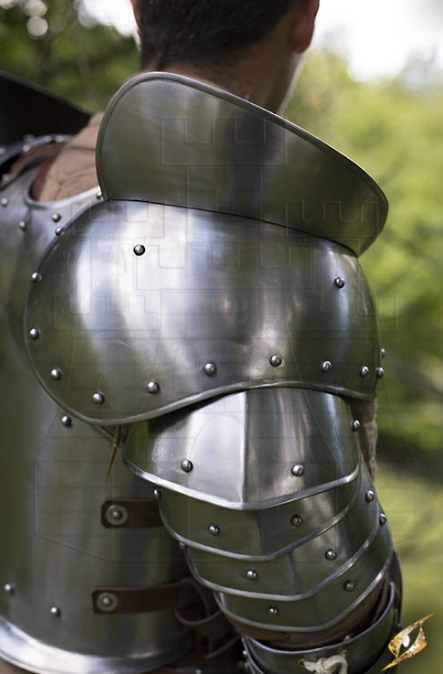
Pauldrons in Tournaments and War Combat: Key Differences
The medieval warrior pauldrons were not uniform. Their design could vary significantly depending on their purpose: whether they were for war or for a tournament. This differentiation is fascinating and reveals the level of specialization that existed in the world of armor.
- War Armors: In war and court harnesses, symmetry was the norm. Both pauldrons were identical, as a warrior had to be prepared to receive blows from any direction. Comprehensive protection was the top priority.
- Tournament Armors: Here the situation changed radically. In jousting tournaments, where combat took place on horseback and contenders faced each other with lances, protection of the left side (the shield side) was paramount. Therefore, the left pauldron was usually much larger and stronger, often with an oversized flange to deflect the impact of the opponent’s lance. Conversely, the right pauldron could be simpler, as it was the lance side and was less exposed.
The Decline of Pauldrons and Armor
The 16th century saw a resurgence of articulated plate pauldrons, but this was a swansong for full armor. The evolution of gunpowder and firearms began to make the use of plate armor obsolete. Muskets and arquebuses could relatively easily pierce steel plates, which caused full armor, with its medieval pauldrons, to lose its effectiveness and relevance on the battlefield.
Although the breastplate and some torso protection pieces remained for a time, pauldrons, in their complex and articulated form, ceased to be used. The last pauldrons are, for the most part, repetitions of previous models, without major innovations, as armor was in a clear process of decline.
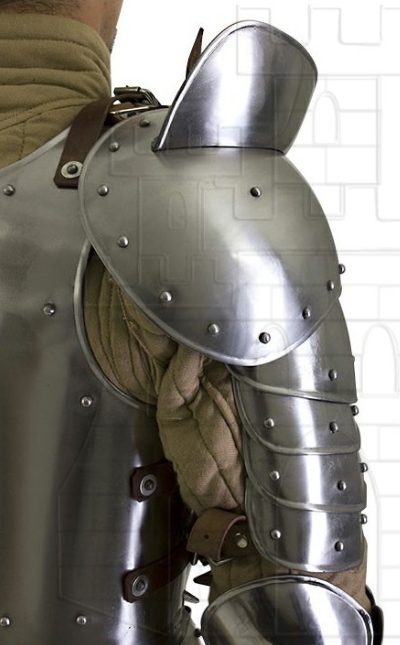
How to Choose Your Medieval Pauldrons
If you are a re-enactor, collector, or simply a history enthusiast, choosing the right pauldrons is essential to complete your armor. Here is a quick guide to help you make the best decision:
- Simple Plate Pauldrons: Ideal for representations of warriors from the late 13th or early 14th century. They are lighter and perfect if you are looking for a more historical and less ostentatious approach.
- 15th Century Articulated Pauldrons: If your interest is focused on the heyday of full armor, these are your best option. They are larger and offer a more imposing aesthetic. Make sure the articulations are of good quality for realistic mobility.
- Tournament Pauldrons: If you want to recreate the jousting experience, look for asymmetrical pauldrons. The left pauldron should be noticeably larger and more robust. They are perfect for standing out in events and tournament re-enactments.
The quality of the materials is key. Look for sweet steel or heavier gauge pieces to ensure durability. The leather straps must be strong and the buckles solid to keep them in place during use.
The medieval warrior pauldrons are much more than simple accessories; they are a testament to human ingenuity for protection. If you are looking to add these pieces to your collection or re-enactment attire, it is essential to understand their history and function to appreciate their true value.
